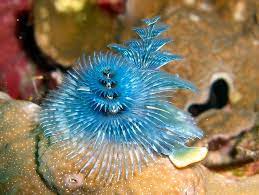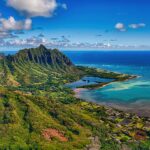In the mesmerizing realm of coral reefs, the Christmas tree worm (Spirobranchus giganteus and Spirobranchus corniculatus) stands as a captivating spectacle of marine life. Named for their striking resemblance to a decorated Christmas tree, these colorful marine worms have become a beloved symbol of the holiday season for divers and ocean enthusiasts worldwide. In this blog, we will explore the intriguing world of the Christmas tree worm, diving into their unique characteristics, symbiotic relationships, and their crucial role in coral reef ecosystems.

- A Festive Sight:
The Christmas tree worm’s most distinctive feature is its twin crown-like structures, called radioles, which protrude from its calcareous tube. These radioles come in an array of vibrant colors, ranging from reds and yellows to blues and greens, resembling the festive decorations adorning a Christmas tree.
- Habitat and Distribution:
Christmas tree worms are predominantly found in tropical oceans worldwide, particularly in coral reefs. They are well-suited to a life among the corals, as they are filter-feeding organisms that thrive in the nutrient-rich waters of these marine habitats.
- Feeding Behavior:
The Christmas tree worm is a suspension feeder, meaning it captures tiny plankton and organic particles from the water using its feathery radioles. As ocean currents pass over them, the worms extend their radioles into the water to collect food, a fascinating spectacle to witness underwater.
- Symbiotic Relationship:
The Christmas tree worm forms a mutualistic relationship with the coral polyps on which they live. The worm benefits from the shelter provided by the coral, while the coral benefits from the worm’s continuous cleaning of its surface, helping to remove debris and excess mucus.
- Sensitivity to Threats:
Christmas tree worms are highly sensitive to disturbances in their environment, such as changes in water temperature and pollution. They retract their colorful radioles when they sense danger, rapidly disappearing into their protective tubes.
- Reproduction and Life Cycle:
The reproductive process of Christmas tree worms involves the release of gametes into the water column, where fertilization takes place. The fertilized eggs develop into free-swimming larvae, which eventually settle on the coral substrate and begin building their protective tubes.
- Biodiversity in Coral Reefs:
The presence of Christmas tree worms is indicative of a healthy and biodiverse coral reef ecosystem. Their colorful appearance contributes to the vibrant mosaic of life found in coral reefs, attracting divers and snorkelers to explore these rich underwater habitats.
- Threats and Conservation:
Like many marine organisms, Christmas tree worms face various threats, primarily due to human activities such as overfishing, pollution, and climate change. As coral reefs worldwide face bleaching events and degradation, it is essential to implement conservation efforts to protect these delicate marine creatures and their habitats.
- Ecological Importance:
Beyond their aesthetic charm, Christmas tree worms play a vital role in maintaining the health of coral reefs. As filter feeders, they help control plankton populations, promoting a balanced ecosystem. Moreover, their presence indicates the overall health and biodiversity of coral reefs.
Conclusion:
The Christmas tree worm is a captivating example of nature’s creativity, with its striking resemblance to a festive holiday decoration. Found in coral reefs worldwide, these marine worms not only add splashes of color to the underwater landscape but also play an essential role in maintaining the health and diversity of coral reef ecosystems. As we strive to protect and conserve our ocean environments, the Christmas tree worm serves as a reminder of the delicate beauty and ecological importance of these underwater wonderlands.



















Add Comment